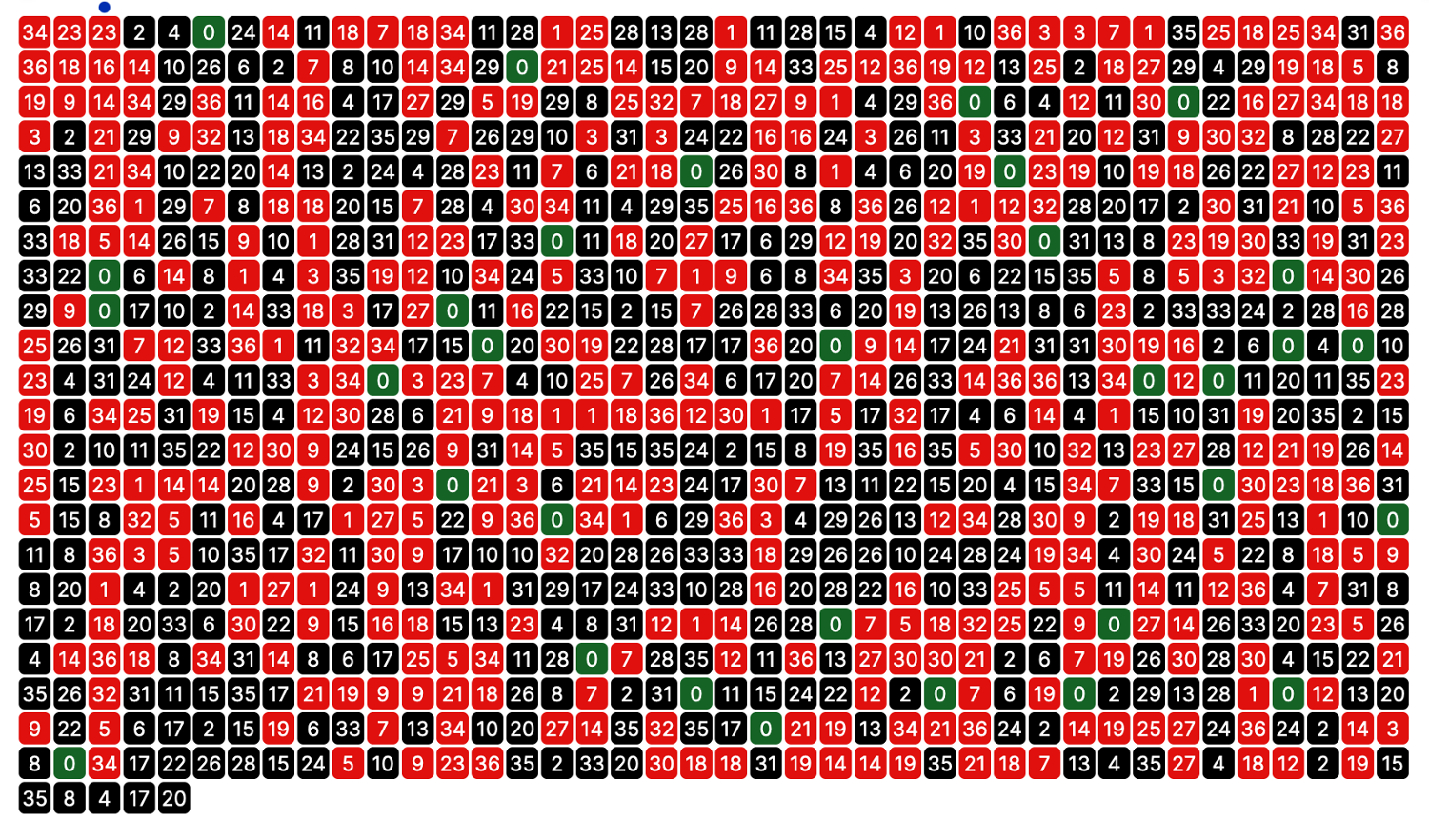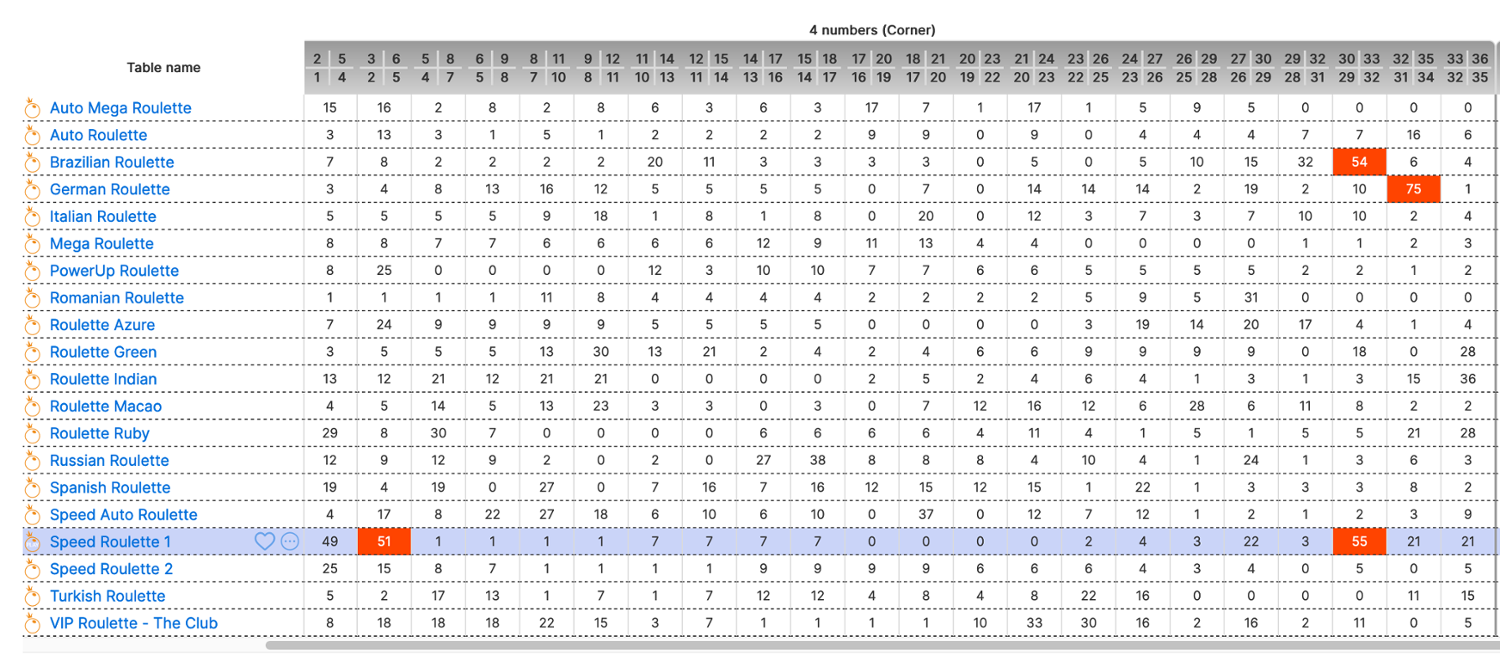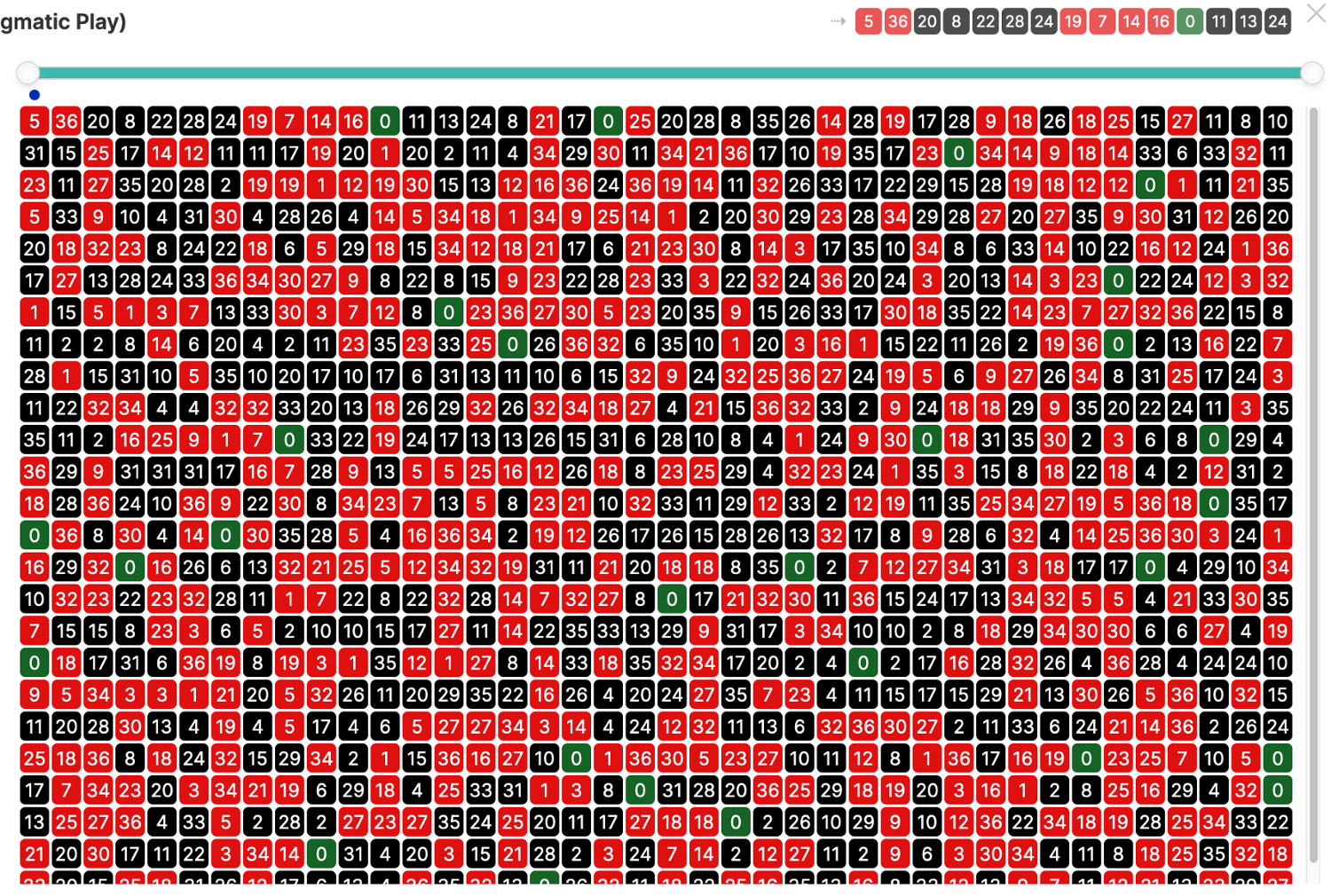Entonces, pasé algún tiempo observando situaciones de juego en docenas (para ser precisos, 80) de mesas de ruleta en línea en tiempo real para verificar lo que escribiste. Observé durante aproximadamente 5 a 6 horas seguidas y mis ojos se cansaron mucho al mirar estos números. Sin embargo, fue interesante descubrir esta nueva estrategia para mí.
Primero puedo decir que es una muy buena estrategia ; se juega como usted escribió y las apuestas ganan en la mayoría de los casos (yo diría que entre el 98% y el 99% de las veces).
Desgraciadamente, no siempre se gana : surgen situaciones, como supuse en mis mensajes anteriores, en las que el número de fallos supera el límite fijado por tu estrategia.
Inicialmente, decidí mirar todas las esquinas que no aparecen 26 o más veces, buscar tablas donde haya más de 2 de esas posiciones y, entre ellas, no haya intersecciones numéricas. Fue muy informativo, pero desafortunadamente fue mi error porque hay muchas tablas de este tipo y fue un desafío rastrear las relevantes.
Sin embargo, casi de inmediato (después de una hora de observación) encontré el problema (proporciono imágenes a continuación):


Como puede ver aquí, en la tabla resaltada (EZugi, Oracle 360 Roulette), hay dos de las esquinas más raras: "19,20,22,23", 56 fallos seguidos y "29,30,32,33". " — 50 fallos. Seguí esta tabla entre muchas donde los errores llegaron a 26. En la segunda imagen, te doy los números que salieron en esta ruleta para que puedas contar por ti mismo si no confías en mí. Coloqué un círculo azul encima del número en el que habría ganado la apuesta (surgió 23), para que puedas usar este número como referencia y mirar los números de la derecha y de abajo en orden.
Por cierto, esta mesa se encuentra en un casino real donde la gente hace apuestas con fichas. Sólo tiene la capacidad de aceptar apuestas en línea. Mencioné esto para mostrar que en este caso, según su estrategia, habría tenido que esperar menos de 26 fallos, lo cual es aún peor. Sin embargo, esperé el 26.
En aproximadamente 5 o 6 horas de observación, conté alrededor de 12 situaciones de este tipo en las que el número mínimo de fallos de dos saques de esquina que no aparecieron excedieron 50, es decir, cuando la progresión de su apuesta habría excedido los límites de apuestas declarados. El número máximo de errores en mis observaciones alcanzó 61 veces, esto sucedió en la mesa Roulette Green, proveedor Pragmatic Play Live, la esquina "26,27,29,30" no apareció 80 veces y la esquina "8,9,11, 12" - 61 veces . Desafortunadamente, debido al cansancio por la observación, olvidé tomar una captura de pantalla.
Mucho más tarde, descubrí que podía aumentar los límites de observación de las tablas para que al realizar el seguimiento solo se resaltaran aquellos recuentos de errores que excedieran 50. Esta observación simplificó significativamente, pero la hice bastante tarde. Otro ejemplo más para usted en las capturas de pantalla a continuación:


Tabla ``'Speed Roulette 1', proveedor Pragmatic Play Live, esquina "29,30,32,33" — 55 fallos y "2,3,5,6" — 51 fallos. Nuevamente, te doy los últimos 1000 números que aparecieron en esa tabla para que puedas comprobarlo tú mismo. El círculo azul encima de un número muestra que aquí tus apuestas ganarían. Desafortunadamente, se necesitaría demasiado dinero para apostar después de la cantidad de fallos mostrada.
Supongo que el autor de esta estrategia simplemente no tuvo la oportunidad de observar una gran cantidad de tablas simultáneamente para ver los resultados que proporcioné anteriormente. Puedes jugar durante bastante tiempo en una mesa y no perder ni una sola vez con esta estrategia, o puedes perder de inmediato; es cuestión de suerte, y el autor simplemente tuvo suerte.
En conclusión, quiero reiterar que la estrategia es realmente buena , y lo único que se necesita para mejorarla es esperar no a 26 fallos sino al menos a 40 fallos en el límite inferior de curvas que no aparecen para tener éxito.
Puedes creerme o no, es tu derecho. Estaba realmente interesado en este enfoque y me esforcé mucho para descubrir qué tan exitoso es, y ahora puedo sacar conclusiones basadas en datos reales, no en suposiciones. Quizás esta información le ayude a usted (o a alguien más interesado en esta estrategia) a evitar perder dinero.
So, I spent some time observing game situations on dozens (to be precise, 80) of real-time online roulette tables to check what you wrote. I observed for about 5-6 hours straight, and my eyes got very tired looking at these numbers. Nevertheless, it was interesting to discover this new strategy for me.
First I can say it's a very good strategy; it plays as you wrote, and bets win in the majority of cases (I would say about 98-99% of the time).
Unfortunately, it doesn't win always: situations arise, as I assumed in my previous messages, when the number of misses exceeds the limit set by your strategy.
Initially, I decided to look at all corners that don't appear 26 or more times, find tables where there are more than 2 of such positions, and among them, there are no number intersections. It was very informative, but unfortunately, it was my mistake because there are many such tables, and it was challenging to track the relevant ones.
Nevertheless, I almost immediately (within an hour of observation) found the issue (I provide pictures below):


As you can see here, on the highlighted table (EZugi, Oracle 360 Roulette), there are two of the rarest corners — "19,20,22,23" — 56 misses in a row and "29,30,32,33" — 50 misses. I tracked this table among many where the misses reached 26. In the second picture, I give you the numbers that came up on this roulette so you can count for yourself if you don't trust me. I placed a blue circle above the number when the bet would have won (23 came up), so you can use this number as a reference and look at the numbers to the right and down in order.
By the way, this table is in a real casino where people place bets with chips. It just has the capability to accept bets online. I mentioned this to show that in this case, according to your strategy, I would have had to wait for less than 26 misses, which is even worse. Nevertheless, I waited for 26.
In about 5 or 6 hours of observation, I counted about 12 such situations where the minimum number of misses from two non-appearing corners exceeded 50, i.e., when your bet progression would have exceeded the declared betting limits. The maximum number of misses in my observations reached 61 times, this happened on the table Roulette Green, provider Pragmatic Play Live, corner "26,27,29,30" did not appear 80 times, and corner "8,9,11,12" — 61 times. Unfortunately, due to fatigue from observation, I forgot to take a screenshot.
Much later, I figured out to increase the observation limits for tables so that only those miss counts that exceed 50 are highlighted when tracking. This significantly simplified observation, but I did it quite late. Just another example for you in the screenshots below:


Table ``'Speed Roulette 1', provider Pragmatic Play Live, corner "29,30,32,33" — 55 misses, and "2,3,5,6" — 51 misses. Again, I give you the last 1000 numbers that came up on that table so you can check it yourself. Blue circle above a number displays that here your bets would win. Unfortunately, it would take too much money to bet after the displayed amount of misses.
I suppose the author of this strategy simply didn't have the opportunity to observe a large number of tables simultaneously to see the results I provided above. You can play for quite a while on one table and not lose once with this strategy, or you can lose right away — it's a matter of luck, and the author just got lucky.
In conclusion, I want to reiterate that the strategy is really good, and the only thing needed for its improvement is to wait not for 26 misses but at least 40 misses on the lower limit of non-appearing corners to succeed.
You can believe me or not — it's your right. I was genuinely interested in this approach, and I tried very hard to find out how successful it is, and now I can draw conclusions based on real data, not assumptions. Perhaps this information will help you (or someone else interested in this strategy) avoid losing money.
Traducción automática:



















